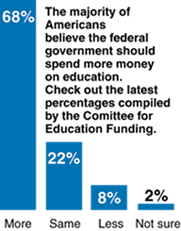CLOVIS
-- The Valley Press Media monitors, collects, analyzes, and reports of
public school data gathered from local regional and from around the nation relating
to public school expenditures, standards, and district governance.
Valley Press publishes reports and specialized analyses of the meaning
and significance of such statistics as a public service to assist state and local
education agencies in improving their statistical systems and education activities.
Valley Press current release includes survey data
empirically agthered by the National Center for Education Statistics. Early
in October 2000, survey forms were sent to each state education agency. States
were asked to complete the form and return it by mail or facsimile. States that
had not responded by mid-November were contacted by telephone. The data was tabulated
and then audited for reliability as to the number of students, teachers,
and high school graduates for public elementary and secondary schools availabe.
Data includes total tax revenues and expenditures for the operation
of public elementary and secondary schools since last year at this time.
Highlights of these statistics reveal there were approximately
47.2 million Prekindergarten through 12th Grade students in the
nation's public schools in last Fall, compared with 46.9 million in Fall 1999.
 Student
membership has increased by 1.5 million since Fall 1996 while. public school students
were taught by an estimated 3.0 million teachers in school year 2000–2001. The
student and teacher count data show a pupil/ teacher ratio of 16.0 for grades
prekindergarten through 12th Grade for public schools over the same
period.
Student
membership has increased by 1.5 million since Fall 1996 while. public school students
were taught by an estimated 3.0 million teachers in school year 2000–2001. The
student and teacher count data show a pupil/ teacher ratio of 16.0 for grades
prekindergarten through 12th Grade for public schools over the same
period.
An estimated 2.5 million public school students graduated
from high school in the 1999– 2000 school year. In the 2000–2001 school year,
2.5 million students are expected to graduate from high school.
Tax revenues for public elementary and secondary education
in fiscal year 2000 are estimated to be $364.0 billion, and they are expected
to rise to approximately $384.7 billion in year 2001.
Current expenditures for public elementary and secondary
education for year 2001 are estimated to be $333.8 billion, an increase of 4.6
percent over the year 2000 estimate of $319.2 billion. The per pupil expenditure
is anticipated to be $7,079 per student in membership for the 2000–2001 school
year.
[Editor's Note: Definitions usd in
the reportsa include the following:
Student Enrollment is the unduplicated count of students
on the roll of the school or local education agency on the school day closest
to October 1. Unless otherwise specified, enrollment includes all students in
Prekindergarten through 12th Grade and ungraded classes.
Teachers refers to professional staff who provide
instruction to students and maintain daily student attendance figures for a group
or class at any of the levels from Prekindergarten through 12th Grade and ungraded
classes. Teacher numbers are reported in full-time equivalents (FTE), which are
computed by dividing the amount of time employed in instruction by the time normally
required of a full-time position.
Pupil/ teacher ratio is the number of students
divided by the number of teachers. The pupil/ teacher ratio for public schools
reported here represents an average across all levels. There is, however, variability
across school districts, Prekindergarten, elementary, and secondary grade levels,
and across programs such as special education and gifted and talented.
Graduates are defined as students receiving a regular
high school diploma during the school year, including summer graduates. Early
estimates are provided for the recent graduates from the 1999– 2000 school year,
with projections for the 2000– 01 school year.
Revenues are defined as additions to assets which
do not incur an obligation that must be met at some future date, do not represent
exchanges of fixed assets, and are available for expenditure by the local education
agencies in the state. Revenues include funds from local, intermediate, state,
and federal sources.
Current Expenditures are funds spent for operating
local public schools and include such items as salaries for school personnel,
student transportation, school books and materials, and energy costs, but exclude
capital outlay and interest on school debt.
Per pupil expenditure (or per pupil revenue) is the
total current expenditure (or revenue) for public elementary and secondary education
in a state divided by the student membership.
The numbers reported here, based on membership, can be
expected to be smaller than per pupil expenditures (and per pupil revenues) based
on average daily attendance, because the membership counts are generally larger
than average daily attendance. As with pupil/ teacher ratio, the average reported
here does not reflect variations across school districts, grade levels, or programs.
The estimates in this publication are key statistics reported
during the 2000–2001 school year. They include the number of students enrolled,
teachers, and high school graduates for public elementary and secondary schools,
and total revenues and expenditures for the operation of public elementary and
secondary schools. Data obtained from "Early Estimates of Public Elementary
and Secondary Education Statistics: School Year 2000– 2001" U. S. Department
of Education. Washington, DC: National Center for Education Statistics.]
Letter to the Editor
©2001 Valley Press Media Network. All
rights reserved.



 Student
membership has increased by 1.5 million since Fall 1996 while. public school students
were taught by an estimated 3.0 million teachers in school year 2000–2001. The
student and teacher count data show a pupil/ teacher ratio of 16.0 for grades
prekindergarten through 12th Grade for public schools over the same
period.
Student
membership has increased by 1.5 million since Fall 1996 while. public school students
were taught by an estimated 3.0 million teachers in school year 2000–2001. The
student and teacher count data show a pupil/ teacher ratio of 16.0 for grades
prekindergarten through 12th Grade for public schools over the same
period.